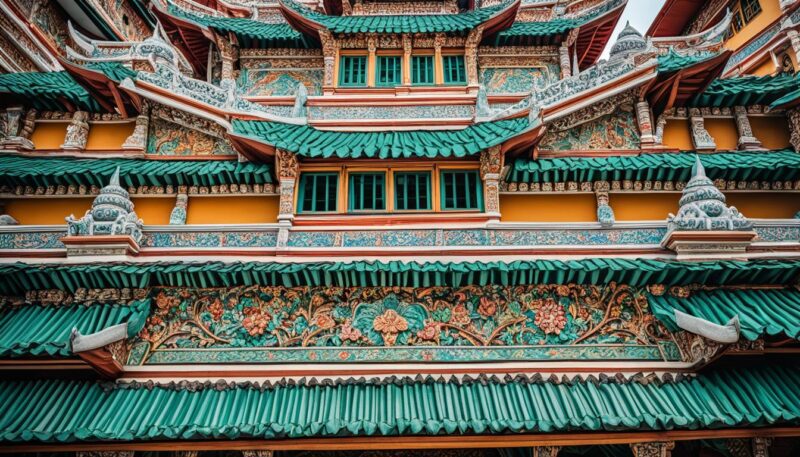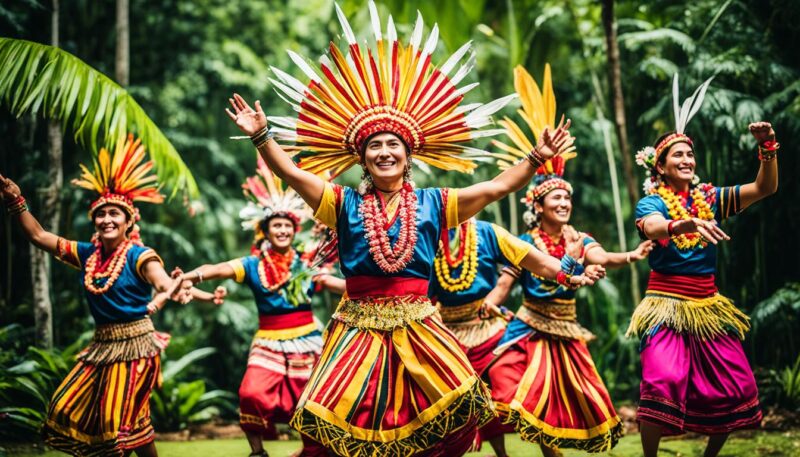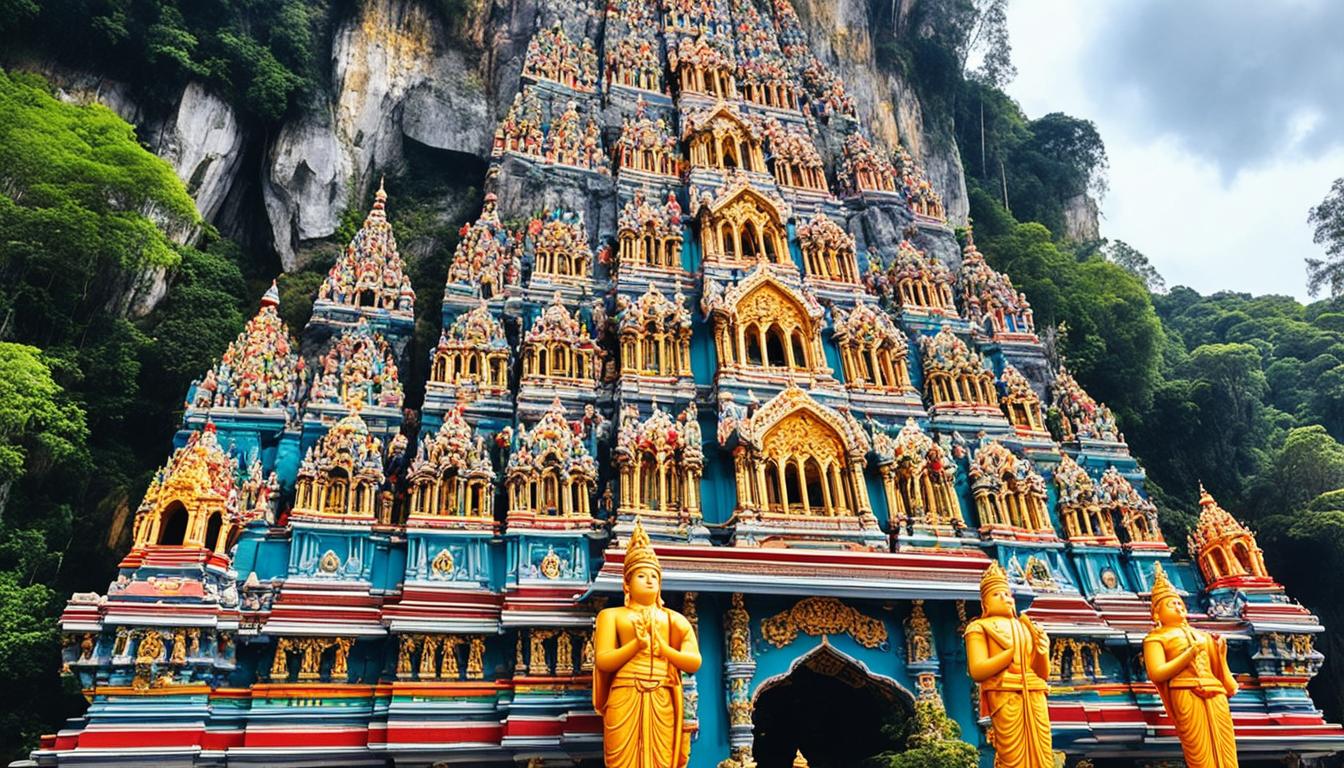Did you know Malaysia was formed in 1965 but has deep cultural roots? It blends Malay, Chinese, Indian, and indigenous influences into a colorful mix. This comes from a history of Malay Kingdoms, European takeovers, and British control.
This Southeast Asian gem is split into Peninsular and East Malaysia. You’ll find harmony in its various cultures. The official language is Malay, but many speak English too. From Kuala Lumpur’s lively streets and the famous Petronas Twin Towers to serene beaches, dense rainforests, and unique wildlife, Malaysia is an exciting place.
Key Takeaways
- Malaysia’s cultural heritage is a rich tapestry of Malay, Chinese, Indian, and indigenous influences.
- The country is divided into Peninsular Malaysia and East Malaysia (Malaysian Borneo), each with its unique blend of cultures.
- Kuala Lumpur, the capital, is a bustling metropolis with iconic landmarks like the Petronas Twin Towers.
- Malaysia’s natural beauty ranges from pristine beaches and tropical islands to ancient rainforests and diverse flora and fauna.
- The official language is Malay, but English is also widely spoken, reflecting the country’s multicultural identity.
Multicultural Festivals and Celebrations
Malaysia is like a mix of many cultures. You can see it in all the festivals and celebrations it has. People there celebrate big events like Hari Raya Aidilfitri, Chinese New Year, Diwali, and Thaipusam. These celebrations let everyone enjoy the country’s traditions, music, and food.
Hari Raya Aidilfitri: Malay Islamic Festival
Hari Raya Aidilfitri is a special time for Malaysians. It marks the end of Ramadan, a month of fasting and reflection. Families come together to celebrate, share gifts, and eat traditional Malay food. This shows the strong Malay culture and religious mix in Malaysia.
Chinese New Year: Vibrant Celebrations
Chinese New Year is eagerly awaited by many in Malaysia. It’s a time of vibrant decorations and lion dances. Families enjoy Chinese food together, and there are parades and fireworks. It’s a time when the streets of Malaysia come alive with color and excitement.
Diwali: Festival of Lights
Diwali is celebrated by Hindus in Malaysia. It commemorates the triumph of good over evil. Streets and homes are lit up with oil lamps and colorful designs. Families share gifts, have special meals, and watch cultural performances. This festival is a great time for everyone to see the country’s diversity.
Thaipusam: Hindu Procession to Batu Caves
Thaipusam is a unique Hindu festival at Batu Caves, near Kuala Lumpur. Devotees carry kavadi or pierce themselves as acts of faith. It’s a dramatic event that shows off Malaysia’s religious life and Hindu heritage.
Architectural Heritage and Influences
Malaysia’s architecture shows its variety of cultural impacts. In cities like George Town and Kuala Lumpur, we see colonial architecture thanks to British, Dutch, and Portuguese influences. This architecture reflects the colonial history that has shaped Malaysia’s buildings.
Colonial Architecture: British, Dutch, and Portuguese
Malaysia boasts a range of European-inspired architecture. This includes grand mansions, shophouses, and fortresses from its colonial era. These historical landmarks are a physical link to Malaysia’s history and the effects of colonization.
Traditional Malay Architecture: Stilt Houses and Longhouses
In rural Malaysia, traditional Malay architecture stands out, especially in Sabah and Sarawak. The unique stilt houses and communal longhouses are signatures of these places. They show the design skills and culture of the indigenous people.
Chinese and Islamic Architectural Influences
Malaysia’s architecture also reflects Chinese and Islamic influences. Throughout the country, you can find gorgeous temples and mosques. These structures highlight the diverse cultural heritage of Malaysia.

Malaysia Culture & Heritage
Malaysia is a blend of many cultures – Malay, Chinese, Indian, and native groups. Its rich culture comes alive in festivals, art, and architecture. This mix has evolved over years, drawing from its past and welcoming new traditions.
The Malay Archipelago’s story goes back centuries, showing a glorious past. The era of the Malacca Sultanate was a key time for cultural exchange. This was when Islam was introduced and became a major part of Malaysia’s identity.
When European nations entered Malaysia, they brought even more cultural fusion. Portuguese, Dutch, and British influences blended with the local ways. The arrival of Chinese and Indian settlers further enriched Malaysia’s cultural heritage.
Today, Malaysia celebrates its rich diversity with festivals and traditions. Events like Hari Raya Aidilfitri, Chinese New Year, and Diwali bring people together. The Thaipusam festival at Batu Caves is one of many events showcasing Malaysia’s unity in diversity.
Malaysia’s identity is seen in its unique music, art, and traditional homes. The nation’s blend of cultures makes it a fascinating place known for its warm hospitality. It’s a true mosaic of Malay, Chinese, Indian, and original cultures.
Traditional Crafts and Artisanal Skills
Malaysia’s culture is full of traditional crafts and skills. People there make beautiful things like fabrics, wood items, and pottery. They use old methods but also come up with new ways to create art. This shows Malaysia’s amazing history of art.
Batik and Songket Textiles
Batik and songket are two famous crafts in Malaysia. Batik uses a special dyeing technique to make colorful patterns on fabric. Songket is a fabric that includes gold or silver threads, making it shiny. Both of these traditional textiles are loved by people around the world for their beauty and cultural meaning.
Wood Carvings and Beadwork
https://www.youtube.com/watch?v=MVsEJYuNZns&ab_channel=BigtownProduction
The Orang Ulu, from East Malaysia, are known for their wood carvings and beadwork. They make everything from large decorative panels to small detailed sculptures. Their beadwork is used in traditional clothing and important items. These crafts are bright, detailed, and significant.
Pottery, Bronze, and Brass Crafts
There’s also a lot of pottery, bronze, and brass making in Malaysia. Skilled craftspeople make a variety of items, from pretty homewares to jewelry. These crafts show off Malaysia’s mix of cultures in their designs. The artisans blend tradition with new ideas, keeping their art alive and fresh.
Indigenous Communities and Traditions
In Malaysia, the indigenous peoples in Sabah and Sarawak keep their rich cultures alive. The Orang Ulu group stands out for their skills in making detailed art. This includes wood carvings, beadwork, and unique spirit sculptures that show their close ties to the land and spirits.
Orang Ulu: Artistic Ability and Spirit Sculptures
The Orang Ulu, meaning “upriver people,” excel in art and craftsmanship. Their unique wood carvings tell stories of mythical beings and ancestors. These are highly valued by those who love art. They are also known for their bright, detailed beadwork on traditional clothing, which highlights their cultural pride.
Traditional Longhouses and Water Villages
Many communities in Malaysia still live in longhouses that can fit up to 100 families. These longhouses are on stilts and show amazing local building skills. They also show how important community living is for these groups.
Some groups also live in water villages. These are built right along the river, showing their strong bond with the water. This bond is a key part of their heritage and sustains them over time.
Unique Customs and Rituals
Malaysia’s indigenous people have a variety of unique customs and rituals. These include ceremonies for their spirit ancestors, healing ways, and important life events. By keeping these traditions alive, they hold onto their cultural history and identity. They also enrich Malaysia’s diverse society with their practices.

Music, Dance, and Performing Arts
Malaysia shines through its music, dance, and performing arts. It has two traditional music groups, the gamelan and the nobat. These groups use unique instruments and rhythms. They show Malaysia’s deep artistic culture, attracting audiences around the world.
Traditional Orchestras: Gamelan and Nobat
The gamelan is a special percussion orchestra known for its beautiful tunes and complex beats. It’s from Java and Bali and has become a key part of Malaysia’s culture. Alongside the gamelan is the nobat, a royal orchestra. It combines wind, string, and percussion sounds. The nobat is famous for its royal and ceremonial music, enhancing traditional events.
Folk Dances: Joget, Mak Yong, and Zapin
Malaysia’s dance traditions are very diverse. The joget is a fun dance influenced by Malay and Portuguese cultures. It is common at social events. The mak yong is a unique dance-drama that tells stories through singing and movements, showcasing Malay heritage. Then, there’s the zapin, a elegant dance from Middle Eastern roots. It shows Malaysia’s blend of cultures.
Martial Arts: Silat
Ancient martial arts also play a big part in Malaysia’s culture. Silat is known for its fast moves and artistic style. It comes from the Malay Archipelago. Silat combines fighting ability with art and philosophy. Practitioners appreciate both the art and spiritual sides of silat, making it a key part of Malaysia’s rich heritage.
Cultural Etiquette and Customs
Understanding Malaysia’s cultural etiquette is key to enjoying its heritage. Greetings, gift giving, and how you dress are all important. By knowing and respecting these customs, your trip will be more rewarding.
Greeting Traditions
In Malaysia, you don’t shake hands with someone of the opposite sex. Instead, nod your head or place your right hand over your heart. This is important because it comes from deep religious and cultural beliefs. Always be respectful when meeting locals.
Gift-Giving Etiquette
When giving gifts in Malaysia, avoid sharp objects. They’re seen as bringing bad luck or ending friendships. Remember to give and receive gifts with your right hand or both. The left hand is used for personal hygiene.
Dress Code Considerations
While Western clothing is fine in Malaysia, especially in cities, you should dress modestly. When visiting traditional or rural places, it’s better to cover up. For women, this means covering shoulders and knees. Men should also wear loose, modest clothes. This shows respect for the local culture.
FAQ
What is the cultural diversity of Malaysia?
Malaysia is a mix of different histories and backgrounds. It has been shaped by Malay Kingdoms, European influence, and British rule. You’ll find a mix of Malays, Chinese, Indians, and indigenous groups. The official language is Malay but English is also common.
What are some of the major cultural festivals celebrated in Malaysia?
The country celebrates several religious festivals. These include Hari Raya Aidilfitri, Chinese New Year, Diwali, and Thaipusam. Each festival marks an important time for different groups. They are celebrated with much joy and vibrant colors.
What are the architectural influences in Malaysia?
Malaysia’s buildings draw from various cultures. You can see British, Dutch, and Portuguese styles, Malay designs, and Chinese and Islamic elements. This mix creates a unique architectural scene across the country.
What are some of the traditional crafts and artisanal skills in Malaysia?
Malaysia is famous for its traditional crafts. Batik and songket textiles are well-loved. There are also intricate wood carvings and beadwork made by the Orang Ulu. Additionally, pottery, bronze, and brass items are part of the country’s craft scene.
How do indigenous communities in Malaysia maintain their cultural heritage?
In states like Sabah and Sarawak, indigenous groups keep their traditions alive. They do this by living in longhouses and water villages. These places are where you can see their unique art, like wood carvings and spirit sculptures.
What are some of the traditional music, dance, and performing arts in Malaysia?
Malaysia boasts a rich performing arts scene. Traditional orchestras such as the gamelan and nobat are important. Folk dances like joget and mak yong reflect the culture. Additionally, the Malay martial art, silat, is a blend of physical skill and art.
What are some important cultural etiquette and customs to be aware of in Malaysia?
Learning Malaysia’s cultural customs is key to enjoying its rich heritage. It’s important to know how to greet others and to give gifts correctly. Also, dressing appropriately, especially in rural areas, shows respect.
Source Links
- https://www.enchantingtravels.com/destinations/asia/malaysia/malaysia-culture/
- https://medium.com/@theveetrahsellvan/my-country-is-malaysia-d77be05983db
- https://www.trailsofindochina.com/destination/malaysia/
